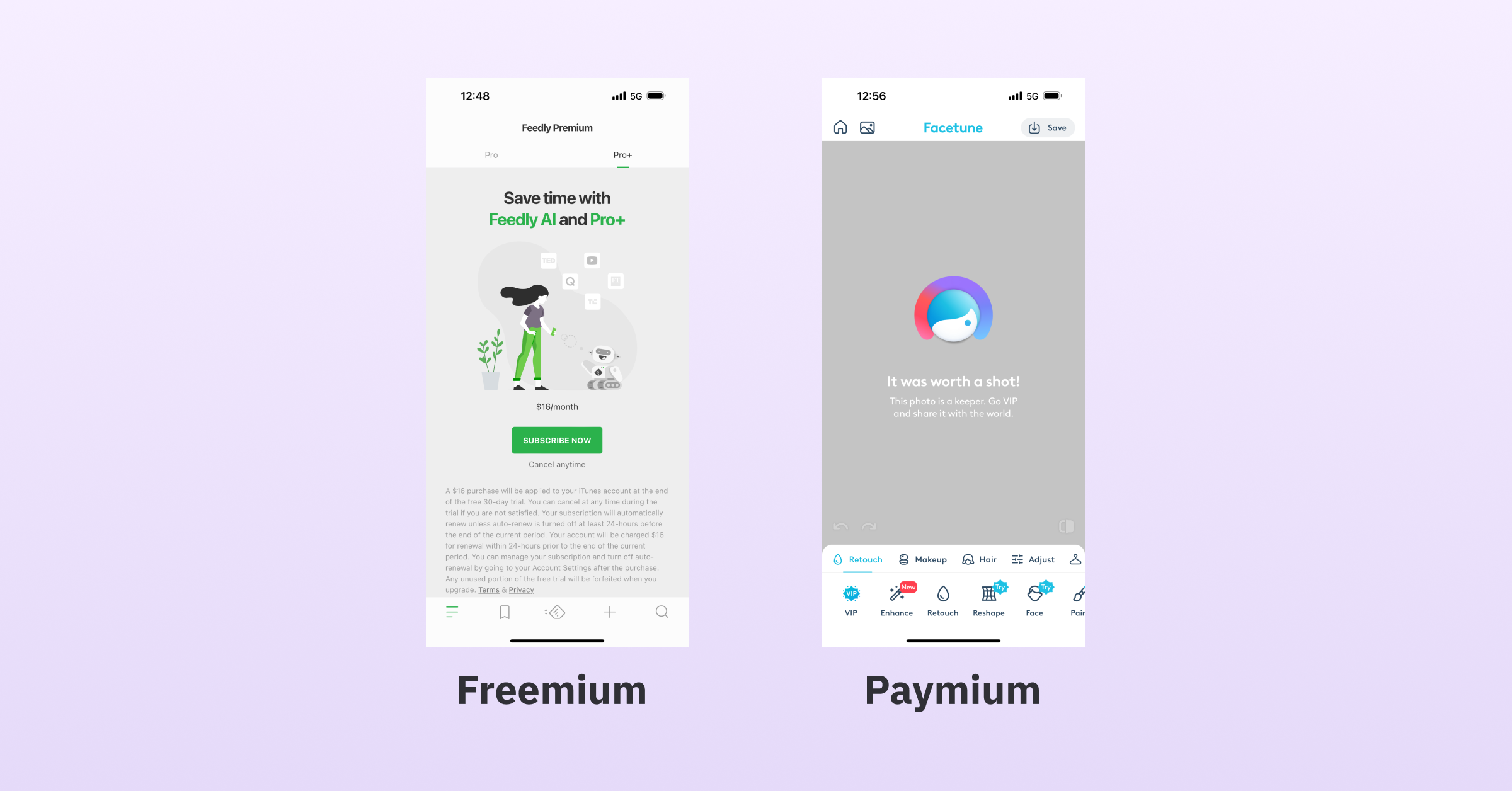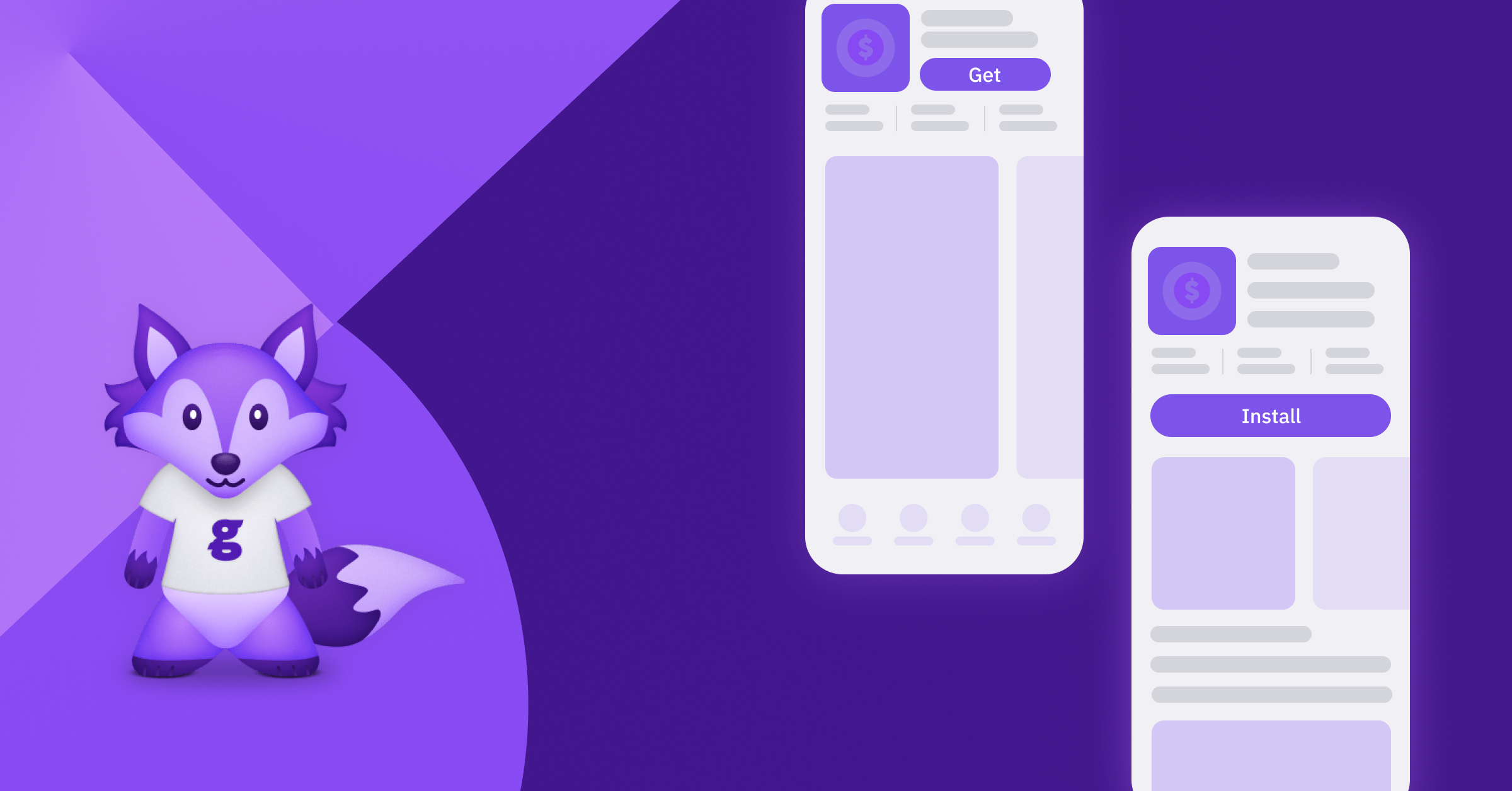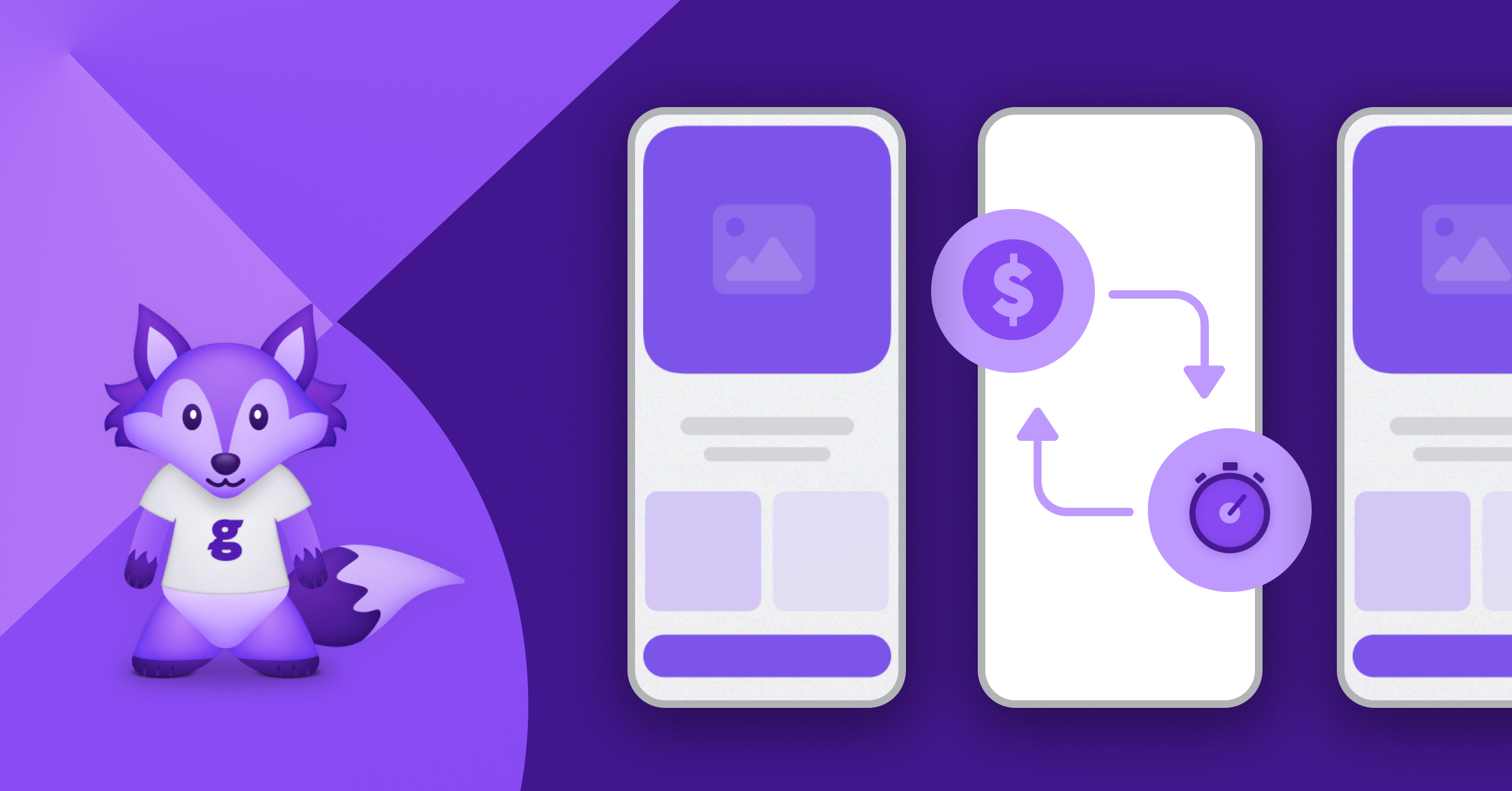Content
In-App Monetization Strategies: A beginners guide

Strategy 1: In-App Purchases
In-app purchases (IAPs) offer users the option to buy virtual goods or additional features within the app. IAPs have evolved significantly and are a major revenue stream for apps. They can be categorized into two main types:
Consumables vs Non-Consumables
- Consumables are items that are used up and then require re-purchasing. For example, in a photo editing app, a consumable might be a one-time use filter or special effect that enhances a single photo.
- Non-Consumables are permanent purchases within an app. An example could be an ad-free version upgrade in a utility app, where users pay once to remove ads permanently.
Understanding the nature of your app and user preferences is key to determining which type of IAPs to offer. There are 2 popular models of monetizing a mobile app with in-app purchases:
1-Freemium Model: Offers a basic version of the app for free, with premium features available at a cost. Premium features can be accessed either through one-time purchases or subscriptions.
This model is effective in monetizing the free user base while offering growth via premium subscriptions.
2-Paymium Model: Users pay to download the app and also for additional in-app features or content. It combines elements of both paid and freemium models. Users initially pay for app access, then have the option to buy extra features or content. This model is suitable for apps where the initial purchase provides basic functionality, with more advanced features available as add-ons.

Did you know
- The Business Research Company reveals that in-app purchase market size is projected to grow from $171.82 billion in 2023 to $213.36 billion in 2024 at a compound annual growth rate (CAGR) of 24.2%.
- Non-gaming apps enjoy a 20% jump in IAP revenue while games are dealing with a 16% drop (Appsflyer).
How to start
Focus on Value: Ensure that in-app purchases offer real value to enhance the user experience.
Transparent Pricing: Be clear about pricing to maintain user trust and avoid surprises.
Optimize for Engagement: Integrate IAPs in a way that feels like a natural part of the app experience.
Key Techniques and Tools
Virtual Goods and Features: Sell items like power-ups, exclusive content or additional functions.
Tools: Platforms like Glassfy, Unity IAP (for games) or Google Play In-App Billing provide comprehensive systems for managing IAPs.
Limited-Time Offers: Create urgency with time-sensitive offers to encourage impulse buying.
Tools: Use Firebase or Localytics to send targeted, time-based promotional notifications.
Tiered Pricing Structure: Offer a range of price points for different types of in-app purchases.
Tools: Analyze user spending patterns with tools like App Annie or Mixpanel to optimize your pricing tiers.
Strategy 2: Subscription Models
Subscription models offer users continuous access to an app’s services or content for a recurring fee. Subscriptions can provide a steady revenue stream and are particularly effective for content, service and utility apps.
Auto-renewable vs. Non-renewable
- Auto-renewable Subscriptions: These are ongoing subscriptions that renew until canceled. They provide a steady revenue stream and are often preferred by users for uninterrupted service.
- Non-renewable Subscriptions: These are one-time subscriptions for a set period. They don’t renew automatically, offering more control to the user but require more effort to maintain subscription levels.
Did you know
- Subscription revenues increased to $45.6 billion in 2023, iOS was responsible for 76% of that revenue. (BusinessofApps)
- App subscriptions generated $45.6 billion in 2023 (BusinessofApps)
How to start
Clear Value Proposition: Ensure that the benefits of subscribing are evident and compelling.
Smooth Onboarding: Provide a seamless onboarding experience to guide users towards subscribing.
Continuous Improvement: Regularly update and improve the content or services offered to keep subscribers engaged and reduce churn.
Key Techniques and Tools
Tiered Subscription Plans: Offer different levels of access or benefits at various price points.
Tools: Glassfy is your completely free in-app subscription infrastructure!
Free Trial Periods: Attract new users and give them a taste of what your app offers before they commit to a subscription.
Tools: Use analytical tools like Glassfy, Adjust or Amplitude to track conversions from free trials to paid subscriptions.
Freemium Model: Provide basic app functionalities for free, with the option to subscribe for premium features.
Tools: Analyze user interactions with the free version versus premium features using Mixpanel or Google Analytics.
Strategy 3: Rewards and Loyalty Programs
Rewards and loyalty programs incentivize continuous engagement and spending within the app. These programs can significantly enhance user retention and lifetime value by rewarding users for their loyalty and engagement.
Transactional vs. Non-transactional
Transactional Benefits: Transactional benefits are directly tied to product or service purchases, offering tangible rewards to users. Key transactional benefits include:
- Coupons: Offering discounts and exclusive deals to customers.
- Codes: Providing special promotions or savings through unique codes.
- Digital Currency: Enabling secure and convenient payments via digital currency options.
- Free Products/Services: Rewarding frequent customers with complimentary items or services.
- Access to Pre-sell or Limited Offers: Granting early or exclusive access to new product releases and limited-time promotions.
Non-Transactional Benefits: In addition to transactional perks, loyalty apps offer non-transactional benefits that enhance the overall customer experience, often unrelated to direct brand offerings:
- No-receipt Returns: Simplifying the return process, eliminating the need for keeping purchase receipts.
- Dedicated Customer Care: Providing personalized support services for an improved customer service experience.
- Enhanced Buying Features: Offering advanced app functionalities like progress tracking and secure payment gateways.
- Invitations to Exclusive Events: Extending special invites to VIP events or exclusive brand experiences.
- Gifts Unrelated to Core Offerings: Surprising customers with gifts that go beyond the standard products or services.
- Free Samples: Allowing users to try new or existing products through complimentary samples.
- Educational Materials: Sharing valuable content and resources to educate and inform users about various topics.
Did you know
- According to a report by Bond Brand Loyalty, 57% of members would like to engage with loyalty programs via a mobile device.
How to start
Align with User Goals: Ensure that the rewards offered align with what users find valuable in the app.
Regular Promotion: Actively promote the loyalty program within the app and through external marketing channels.
Analyze and Adapt: Regularly analyze the performance of your loyalty program and adapt based on user feedback and participation rates.
Key Techniques and Tools
Virtual Currency and Rewards: Implement a system where users earn virtual currency or points for engagement, which can be redeemed for perks.
Tools: Use platforms like Openloyalty or Viral Loops for creating and managing in-app loyalty programs.
Referral Programs: Encourage users to refer new users in exchange for rewards or perks.
Tools: Referral marketing tools like ReferralCandy or Yotpo can be integrated into apps to manage and track referral programs.
Tiered Rewards Systems: Create different levels of loyalty tiers, offering greater rewards as users climb the tiers.
Tools: Kazm or Comarch can help in creating gamified loyalty programs with tiered rewards.
Strategy 4: In-App Advertising
In-app advertising is a strategy where ads are integrated into mobile applications. The goal is to generate revenue while maintaining a positive user experience. Successful in-app advertising involves non-intrusive, targeted ads that are relevant to the user base. Different payment models include:
CPM vs. CPC vs. CPI
- Cost-per-Mile (CPM): Revenuße is earned for every 1000 ad impressions delivered. This model is straightforward and is particularly effective for apps with high user traffic.
- Cost-per-Click (CPC): Payment is made each time an ad is clicked by a user. This model can be highly lucrative if ads are well-targeted and engaging.
- Cost-per-Install (CPI): Revenue is generated each time an app is installed through the ad. This model is ideal for apps focused on expanding their user base.
Did you know
- According to Statista, Mobile advertising spending will reach nearly $413 billion by 2024.
How to start
- User Experience First: Ensure that ads don’t mess with the app’s usability or annoy users.
- Segment and Target: Use user segmentation to deliver targeted ads, increasing relevance and effectiveness.
- Experiment with Ad Formats: Try different ad formats and placements to see what works best for your audience.
Key Techniques and Tools
Non-Intrusive Ad Formats: Use ad formats that don’t disrupt the user experience, such as native ads or rewarded videos.
Tools: AdMob by Google, Facebook Audience Network or Unity Ads offer various non-intrusive ad formats.
Targeted Advertising: Deliver ads based on user data to ensure relevancy and higher engagement.
Tools: Use programmatic advertising platforms like The Trade Desk or MediaMath for targeted ad campaigns.
Native Advertising: Incorporate ads that seamlessly blend with the app’s content and design.
Tools: MoPub, Taboola or Outbrain specialize in native advertising solutions.
Strategy 5: Cross-Promotion
Cross-promotion involves promoting other apps or services within your app. This strategy can increase the reach and downloads of your apps, especially when partnering with apps that have a complementary user base. Cross-promotion is commonly used in the gaming industry.
Banner vs. Interstitial vs. Mid-Sized
Common Ad Formats for Cross-Promotion:
- Banner Ads: Static ads placed at the top or bottom of an app. They are usually non-disruptive to user experience.
- Interstitial Ads: Full-screen ads, which can include video or playable content and typically has a higher CTR.
- Mid-sized Ads: Occupy half of a device screen. They have a balance between banner and interstitial ads in terms of user disruption and awareness. Usually placed if the initial banner ads don’t convert.
Did you know
- The average conversion rate for cross-promotion is 1% to 2% (GameAnalytics)
How to start
Target Complementary Apps: Choose apps for cross-promotion that align with your users’ interests.
Track Performance: Monitor the performance of cross-promotion campaigns and adjust strategies accordingly.
Create Appealing Offers: Make the cross-promotion appealing to users with exclusive offers or content.
Key Techniques and Tools
Cross-Promotion Networks: Use networks to promote your app within other apps.
Tools: AdMob and Chartboost offer platforms for cross-promotion.
Partnerships with Complementary Apps: Partner with apps that offer complementary services to your target audience.
Tools: Tools like Cross.Promo and Tapdaq can help in finding and managing app partnerships.
In-House Cross-Promotion: Promote your other apps or services within your app.
Tools: Use your existing user base and communication channels like email or in-app messages for promotion.
Strategy 6: Affiliate Marketing
Affiliate marketing in mobile apps involves promoting third-party products or services within the app and earning a commission for each sale or referral. This strategy is effective when the promoted offerings align with the interests of the app’s user base. It can be seamlessly integrated into the user experience, adding value without being intrusive.
Did you know
- Mobile affiliate marketing is growing rapidly, with a significant portion of e-commerce sales now generated through mobile devices.
- 70% of all affiliate clicks now come from mobile devices. (WeCanTrack)
How to start
Select the Right Affiliates: Partner with brands and services that resonate with your audience.
Integrate Affiliate Links: Seamlessly incorporate affiliate links into your app’s content or features.
Monitor and Optimize: Track the performance of your affiliate links and adjust strategies for maximum effectiveness.
Key Techniques and Tools
Deep Linking: Use deep linking to direct users straight to product pages, enhancing the likelihood of conversion.
Tools: AppsFlyer offers deep linking solutions tailored for mobile apps.
In-App Content Marketing: Leverage your app’s content to promote affiliate products in a contextually relevant manner.
Tools: Content management tools like Contentful can be used to seamlessly integrate affiliate marketing content within your app.
Mobile-Friendly Affiliate Platforms: Opt for affiliate networks that are optimized for mobile platforms.
Tools: Networks like Awin or Mobidea are specialized in mobile and offer a wide range of affiliate opportunities suitable for app integrations.
Performance Analytics: Use analytics tools specifically designed for mobile apps to track the performance of your affiliate links.
Tools: Adjust and Kochava provide detailed analytics for mobile apps, helping you understand user interactions with affiliate links.
Strategy 7: Data Licensing
Data licensing is a monetization approach where apps generate revenue by licensing user data, such as usage patterns and preferences, to third parties. This strategy must be balanced carefully with user privacy and data protection laws. Effective data licensing can provide valuable insights to other businesses while respecting user consent.
Did you know
- According to IBM, 90% of the world’s data has been created in the last two years, highlighting the immense potential of data licensing.
How to start
Understand Data Regulations: Familiarize yourself with legal requirements related to data privacy and protection. Adhere strictly to data protection regulations like GDPR and CCPA.
Transparency and Consent: Clearly inform users about what data is being collected and how it will be used. Always obtain explicit consent for data sharing.
Anonymization and Privacy: Ensure that the data shared is anonymized and does not compromise individual user privacy.
Implement Data Collection Tools: Use tools to collect and analyze user data while ensuring user consent.
Identify Valuable Data Segments: Determine which data segments are valuable to potential licensees.
Key Techniques and Tools
Data Aggregation and Analysis: Collect and analyze user data to extract valuable insights.
Tools: Platforms like Google Analytics or Mixpanel can be used for data collection and analysis.
Data Anonymization: Ensure user data is anonymized before sharing.
Tools: Tools like ARX Data Anonymization Tool help in anonymizing sensitive data.
Data Management Platforms (DMPs): Use DMPs to manage, store and share data securely.
Tools: Salesforce DMP or Lotame are popular choices for data management and licensing.
Strategy 8: Donations in Mobile Apps
Donations are a monetization strategy where mobile apps encourage users to voluntarily contribute financially in support of the app. This method is particularly effective for apps that offer unique value, such as those in the creative, educational or non-profit sectors. Donations can create a sense of community and user investment in the app.
Did you know
- Donation-based funding is becoming increasingly popular, with platforms like Patreon reporting significant growth in users and revenue.
- A survey by Nonprofits Source found that giving donations have increased by over 205% in the last year.
How to start
Integrate Donation Features: Add easy-to-use donation buttons or links within your app.
Communicate the Impact: Regularly update users on how their donations are making a difference.
Offer Incentives: Consider providing donors with exclusive content or features as a thank you.
Key Techniques and Tools
Donation Management Tools: Donorbox donation software or Fundly SDK for making it easy for users to donate without leaving the app.
Subscription Management for Recurring Donations: Recurly or Chargebee for managing recurring donations, allowing users to set up monthly or periodic donations easily.
Social Proof: Showcase stories or testimonials from users or beneficiaries to highlight the impact of donations.
Tools: Social media integration tools like Hootsuite or Buffer can help share these stories effectively.
Strategy 9: Sponsorships in Mobile Apps
Sponsorship in mobile apps is a collaborative revenue model where an app partners with a brand to create integrated, value-added content for its users. This strategy can be particularly effective for apps with a well-defined user base and those that can offer sponsors targeted access to potential customers.
How to start
Brand Alignment: The success of a sponsorship depends on choosing sponsors whose brand values and target audience align with those of the app.
User Experience: Sponsorship should add value to the user experience, not detract from it. The integration needs to feel natural and relevant.
Sponsored Content: Create content that is sponsored by the brand, such as articles, videos or special features.
Exclusive Offers: Provide users with exclusive offers or access to services/products courtesy of the sponsor.
Examples of Successful Sponsorship
A fitness app partnering with a sportswear brand to offer exclusive discounts.
A music streaming app featuring sponsored playlists or music events from an audio equipment manufacturer.
An educational app integrating sponsored, branded educational content or challenges.
Key Trends in In-App Revenue
Leveraging these trends can give you a competitive edge and help you to adapt to the evolving preferences and behaviors of app users.
Key Trends and Their Implications
- AI and Machine Learning: Using AI for advanced personalization, recommendation engines and predictive analytics to enhance user experience and revenue. IBM Watson, Google AI and TensorFlow are leading tools in this space.
- User Privacy and Data Protection: With growing concerns over data privacy, complying with regulations like GDPR and CCPA is essential for user trust. OneTrust and TrustArc specialize in data privacy management.
- Interactive Ads: Interactive and gamified ads are gaining traction for their high engagement and click-through rates. Tools like Ceros and Apester offer interactive advertising solutions.
- Subscription Economy: A shift towards subscription-based monetization models offers a steady revenue stream. Glassfy is ideal for managing subscriptions.
- In-App Events and Live Streaming: Hosting live events and streaming within apps can engage users and open new revenue channels. StreamYard and Restream are popular for live streaming capabilities.
Monetization options for mobile apps are constantly growing. From subscriptions to data licensing, app developers and app owners can significantly enhance their revenue potential.
The key to maximizing in-app revenue is not just in adopting these strategies, but also in continuously analyzing and refining them. Use data-driven insights to understand your users better, test new approaches and always prioritize the user experience.
Keeping users engaged, satisfied and loyal is the foundation upon which all these strategies will thrive.
Read More




